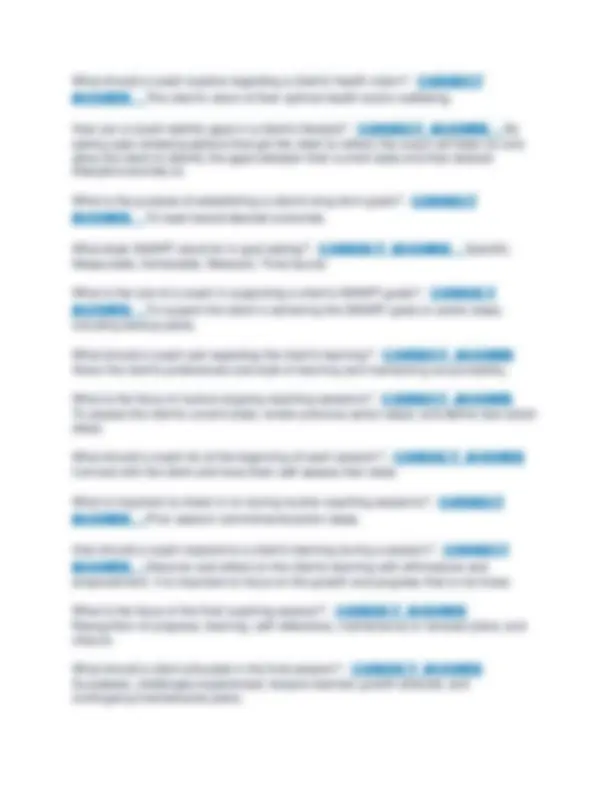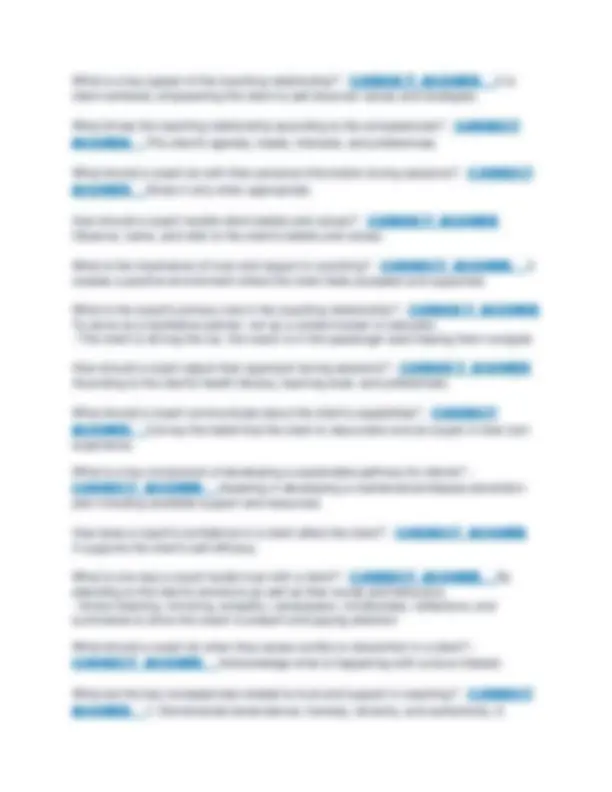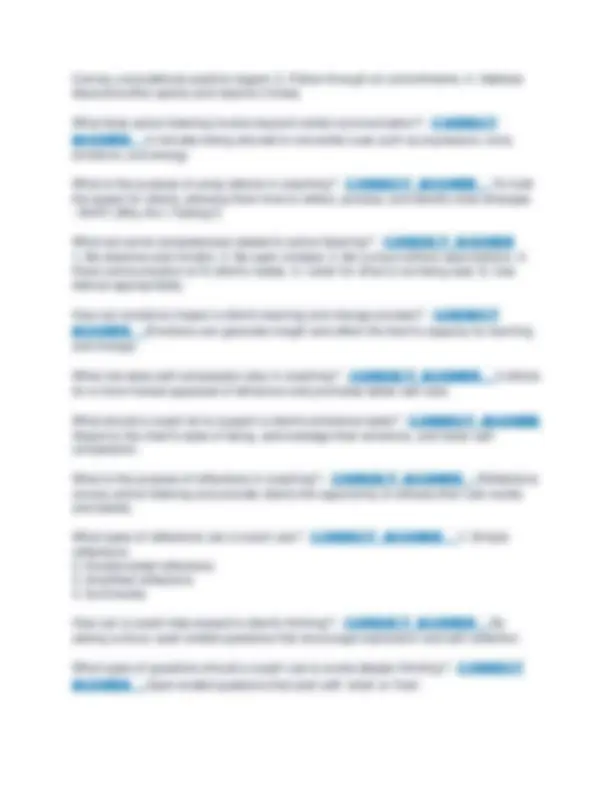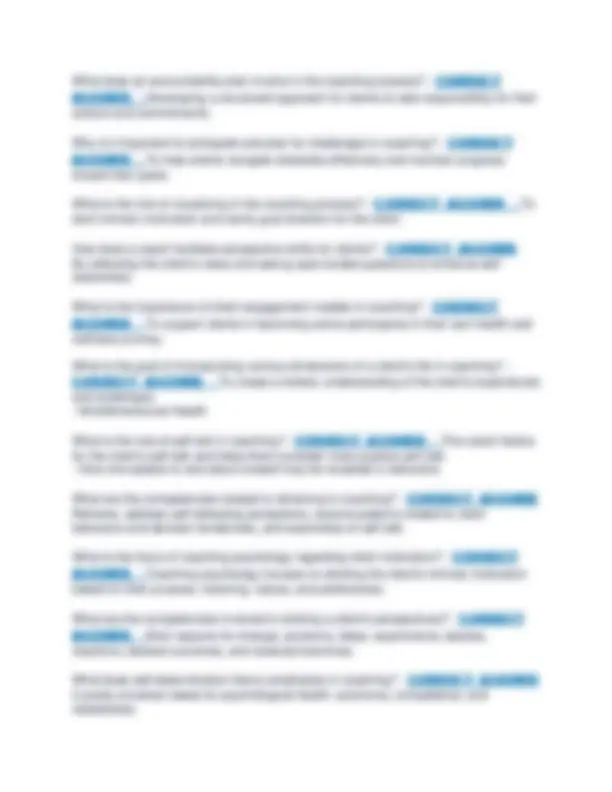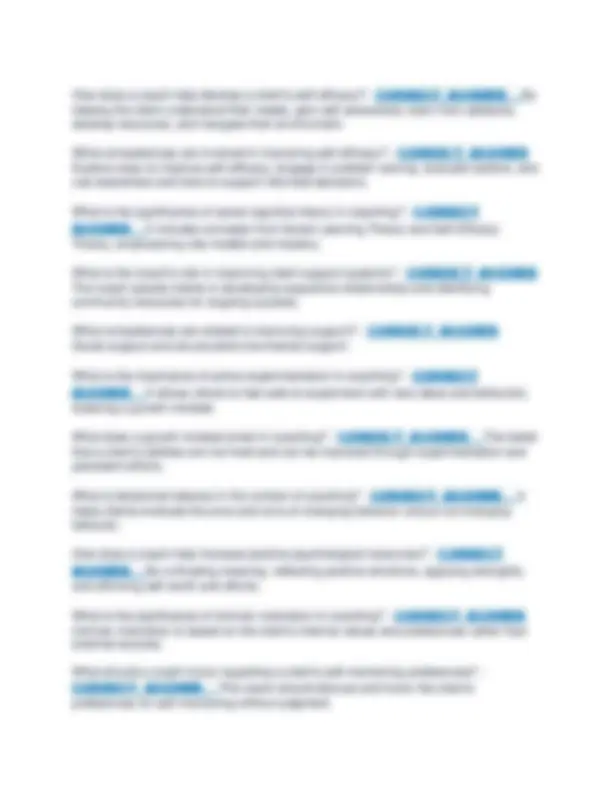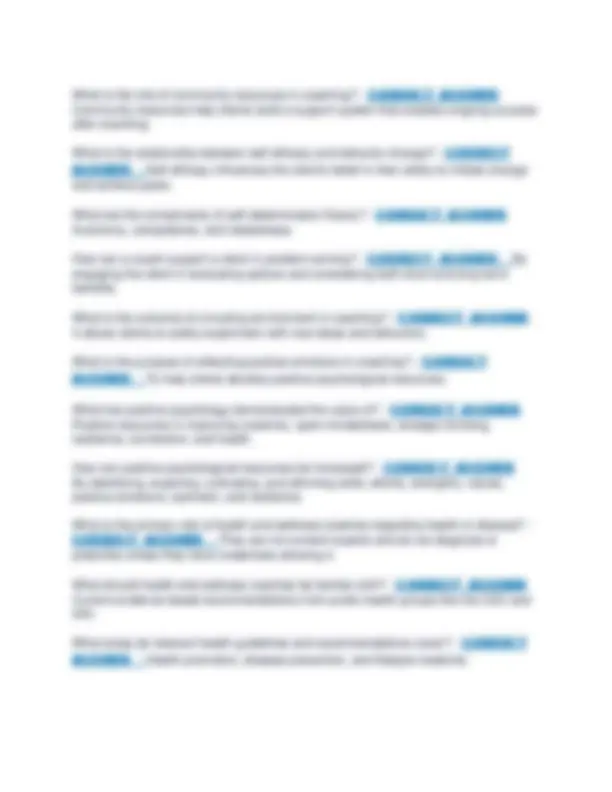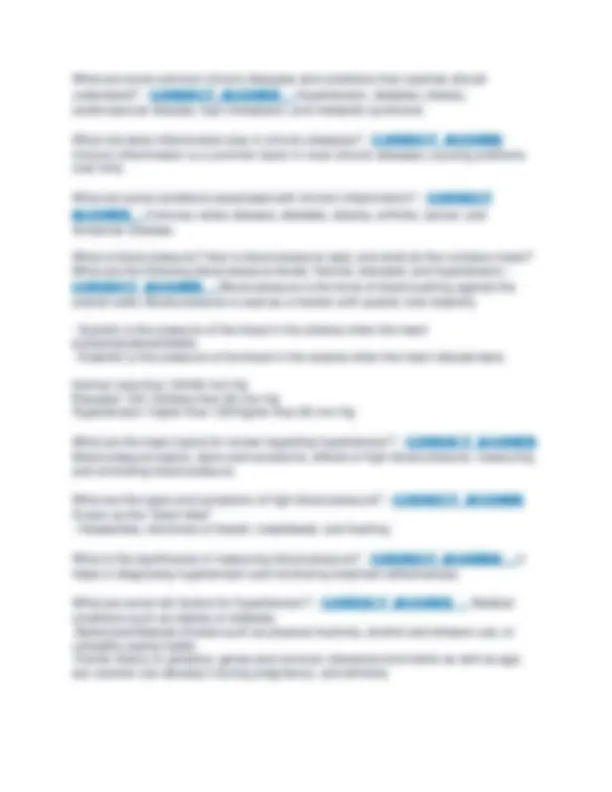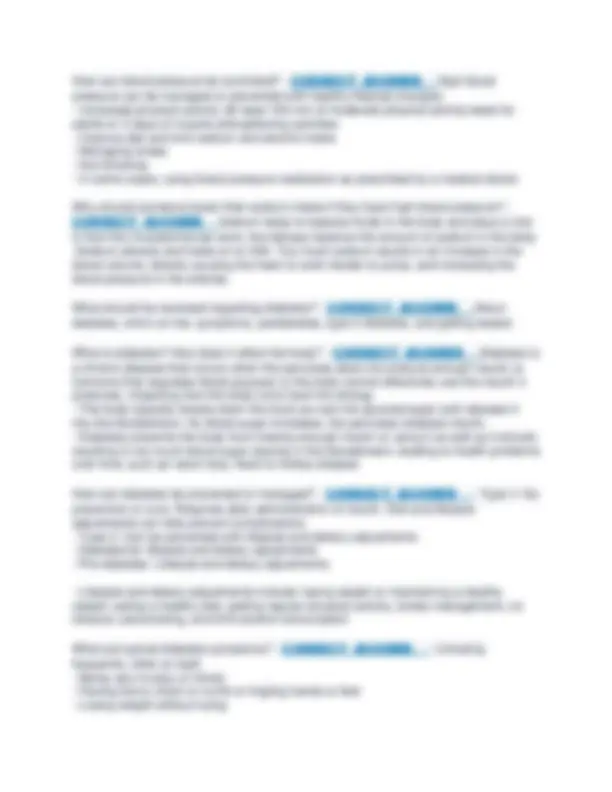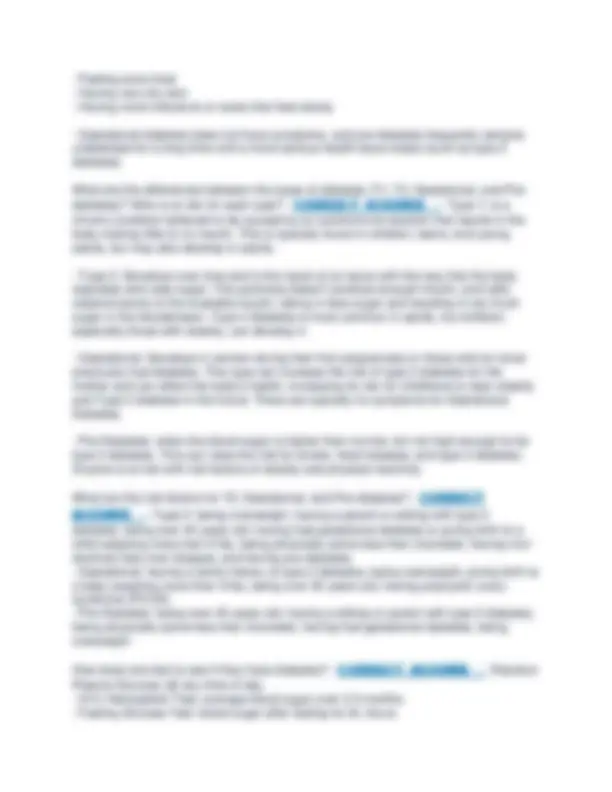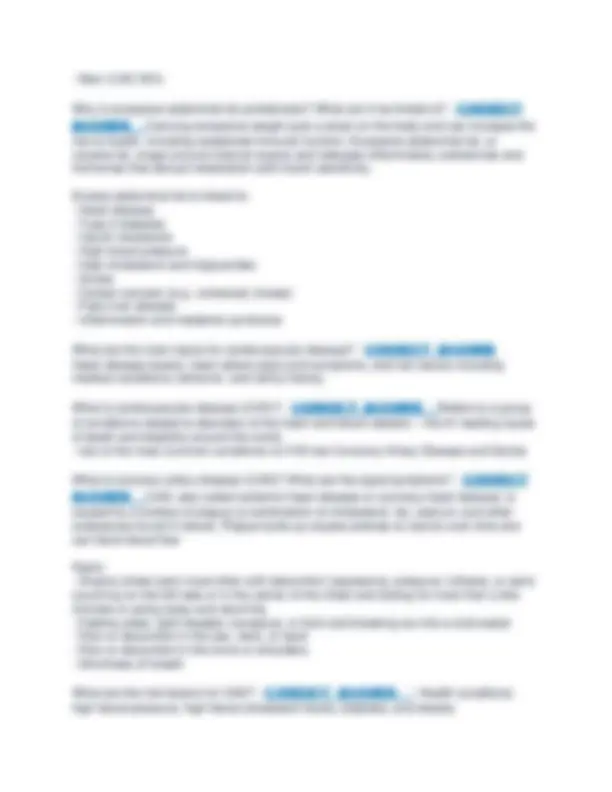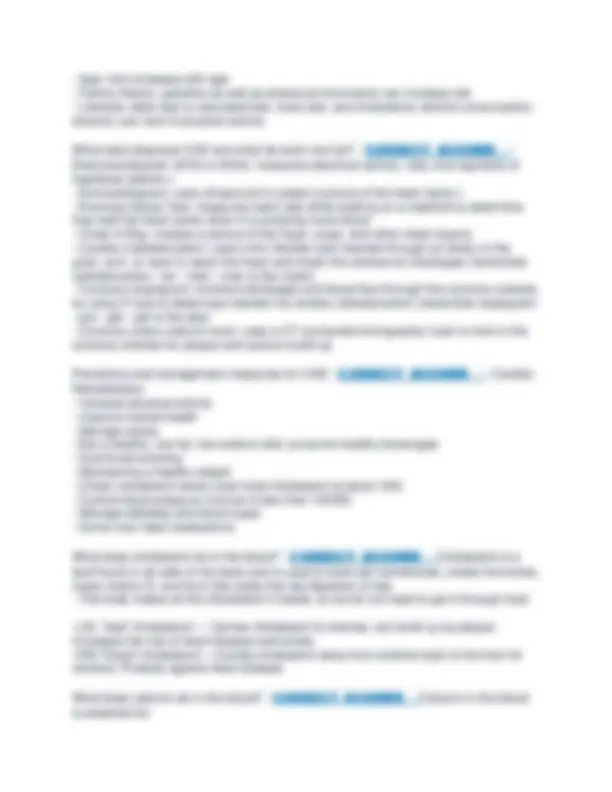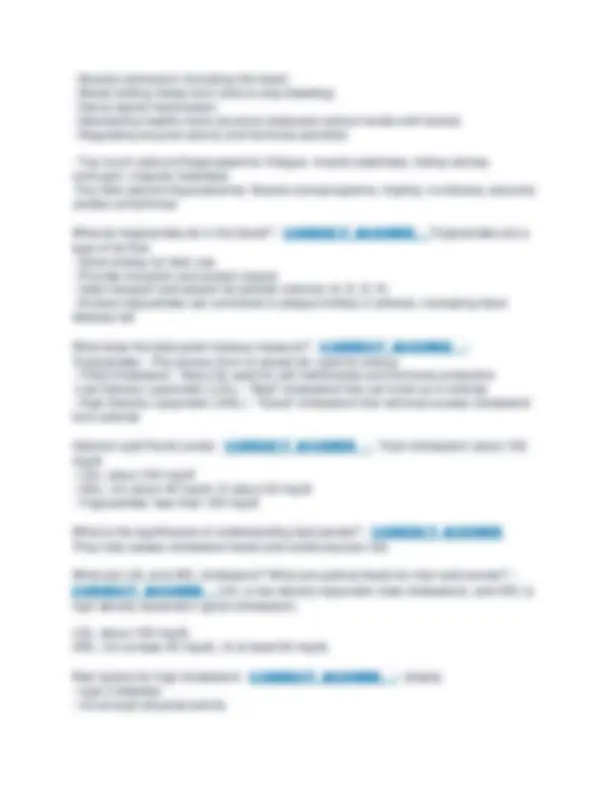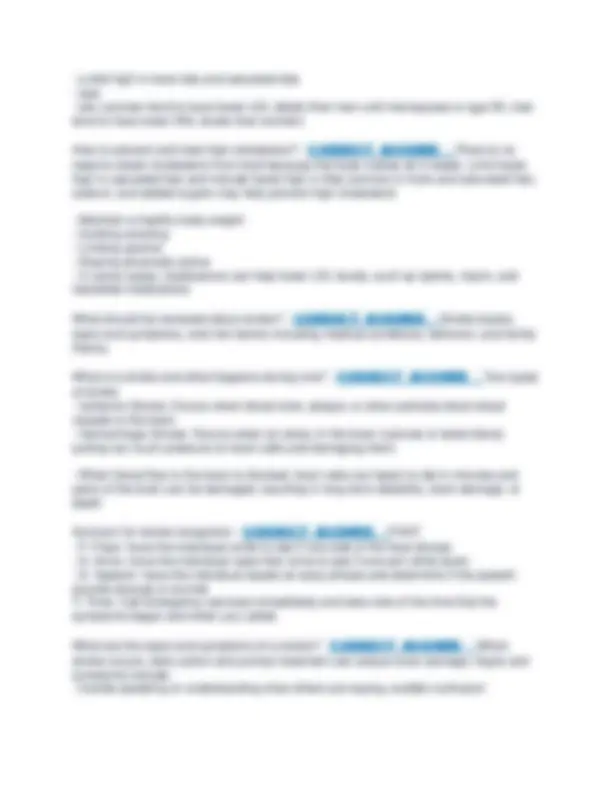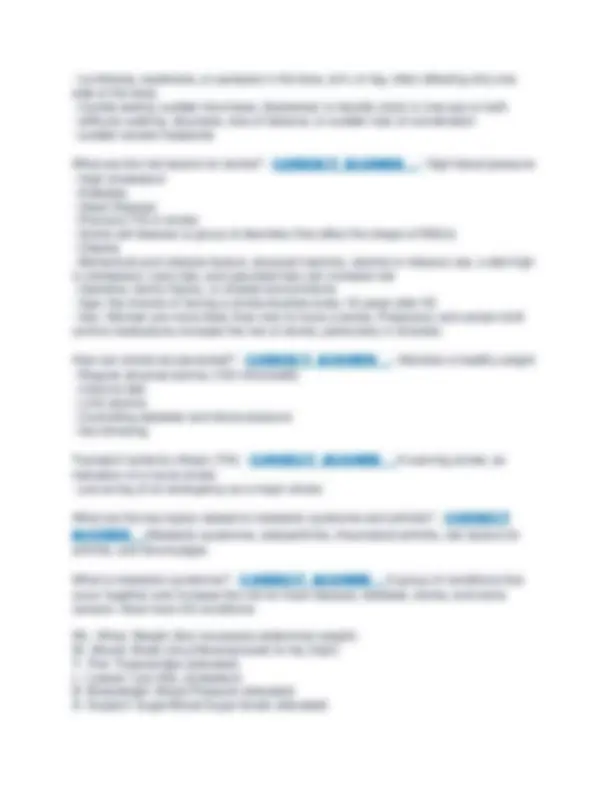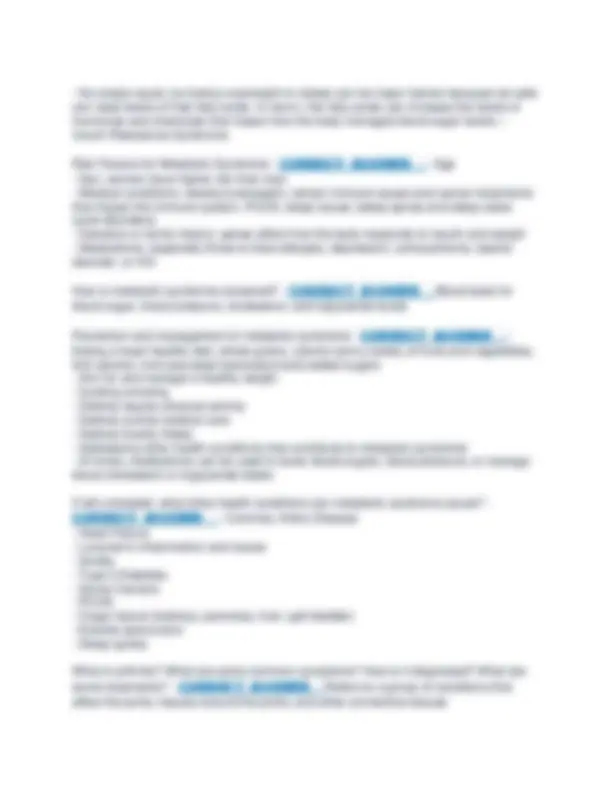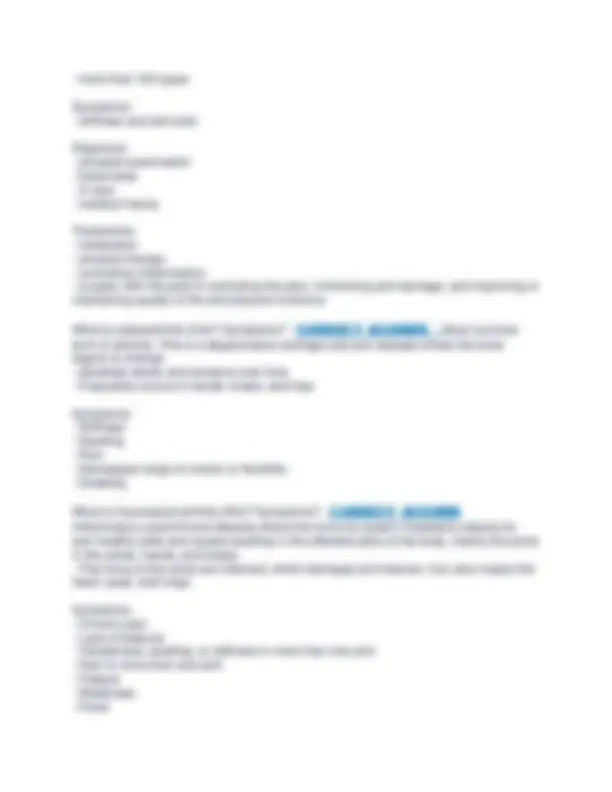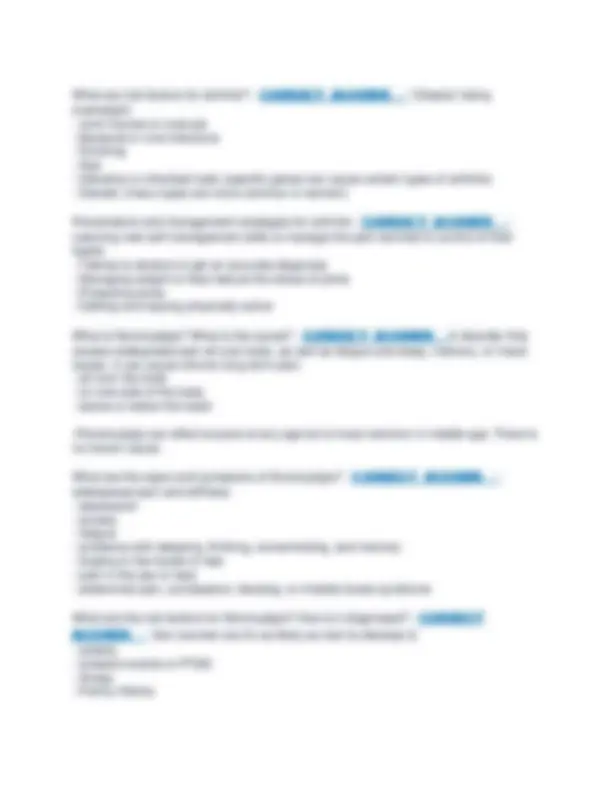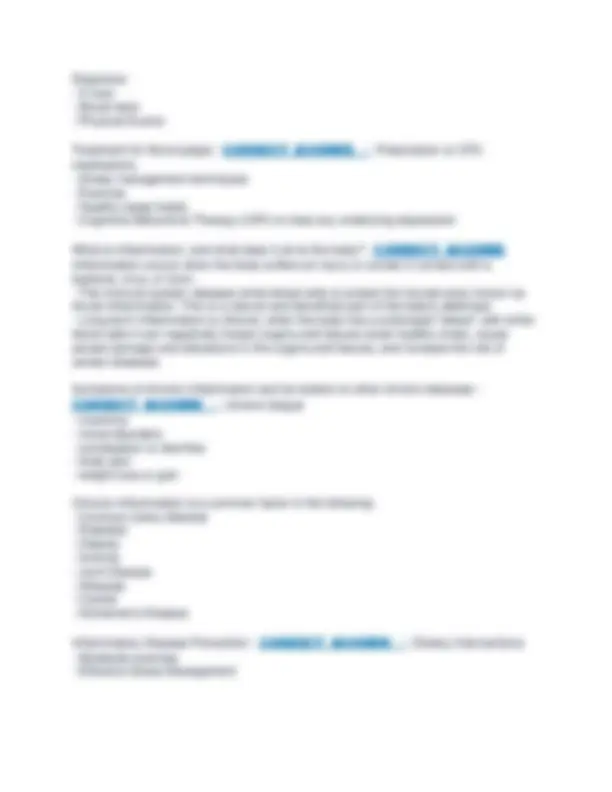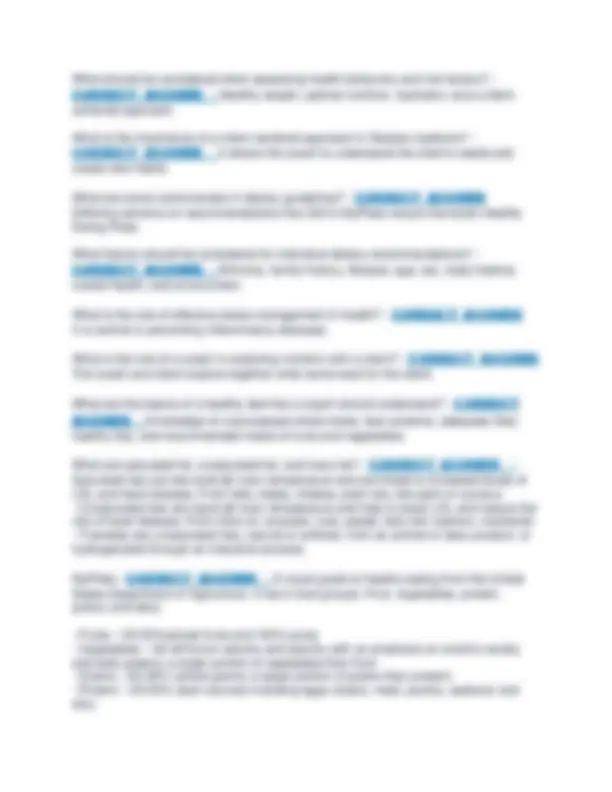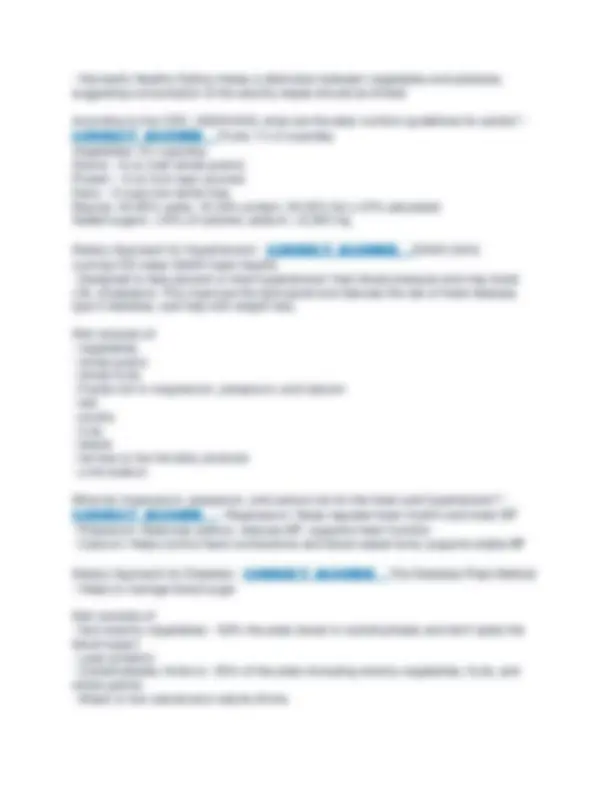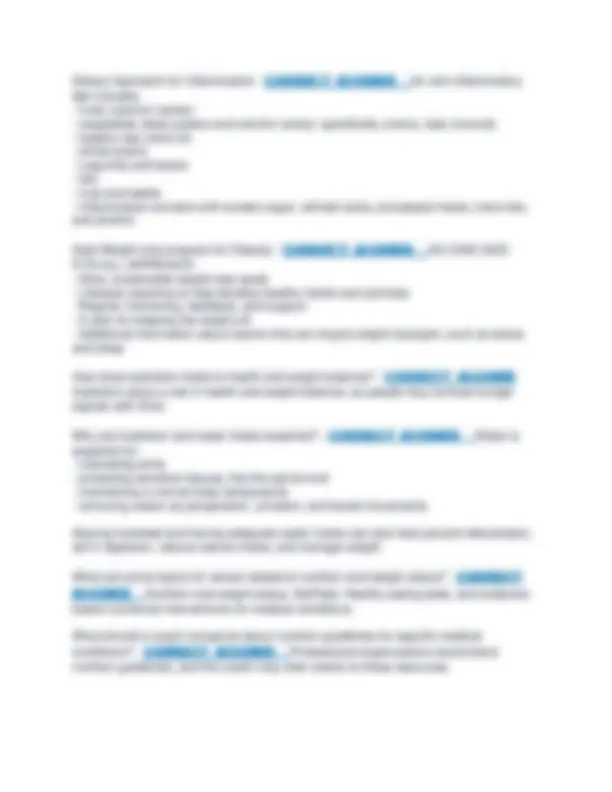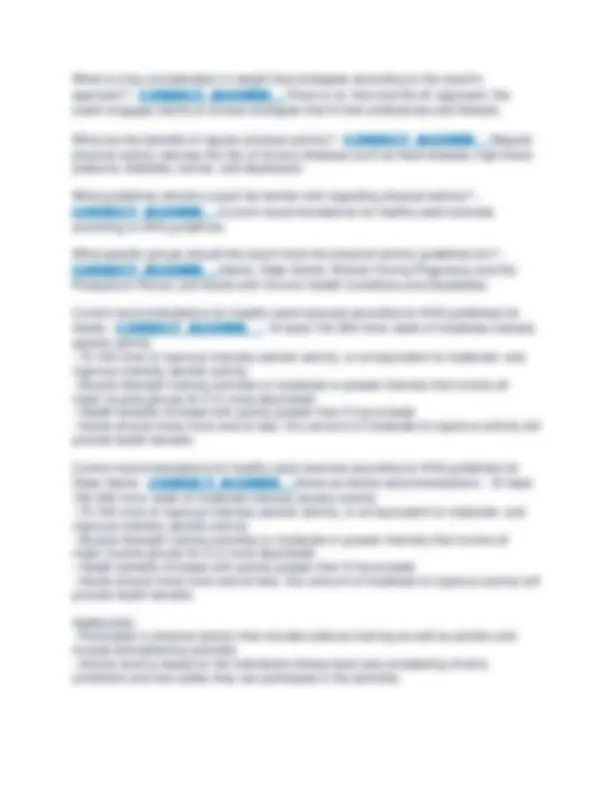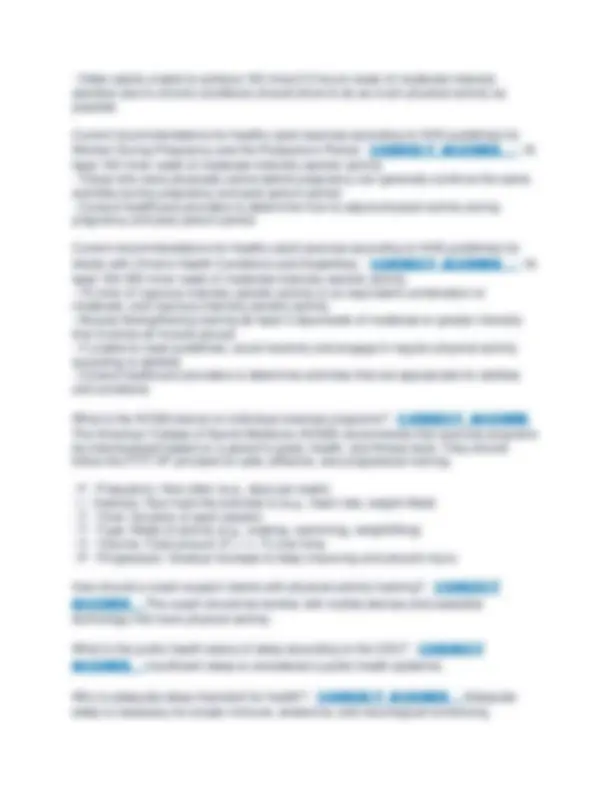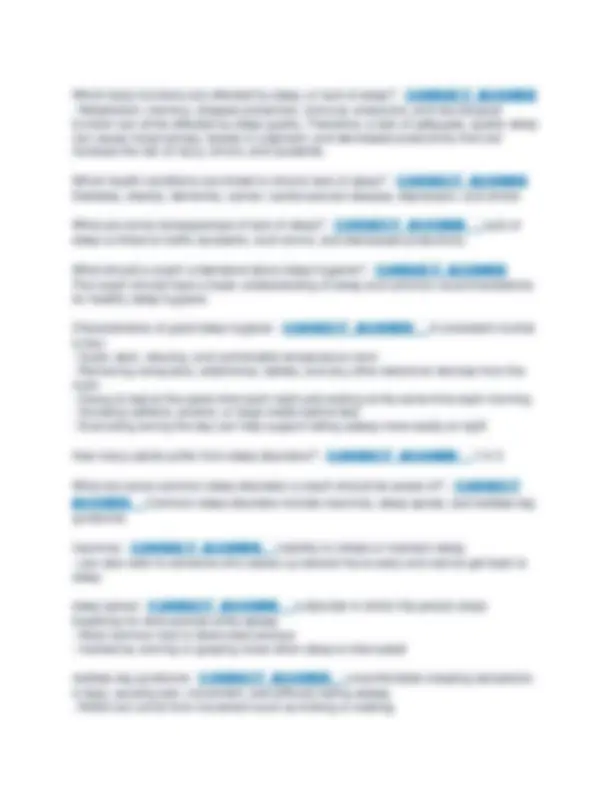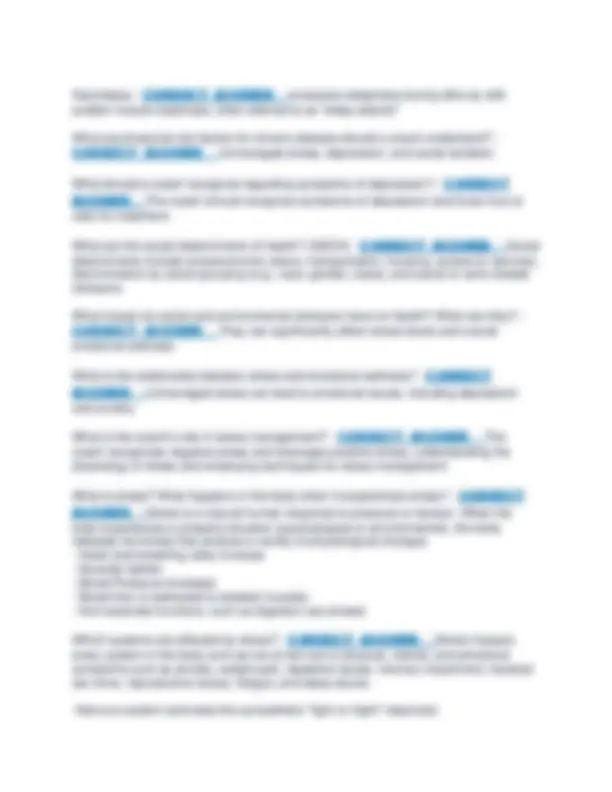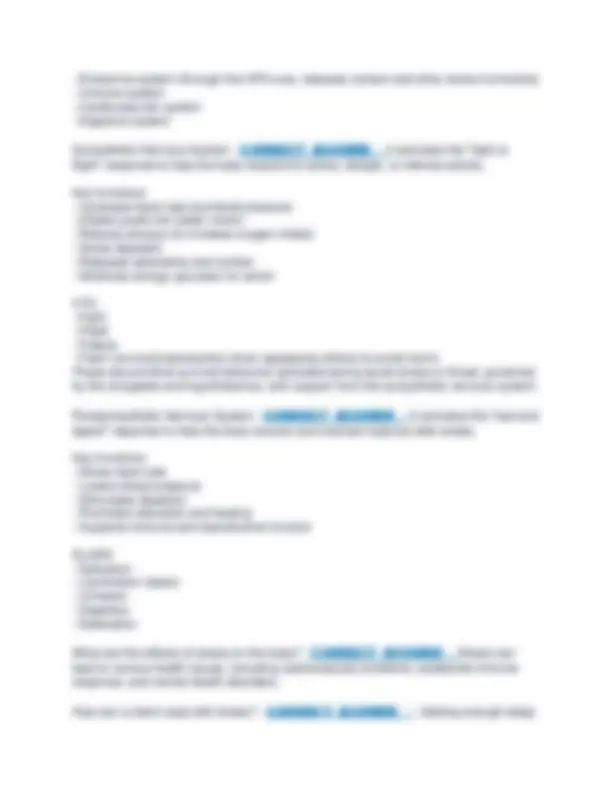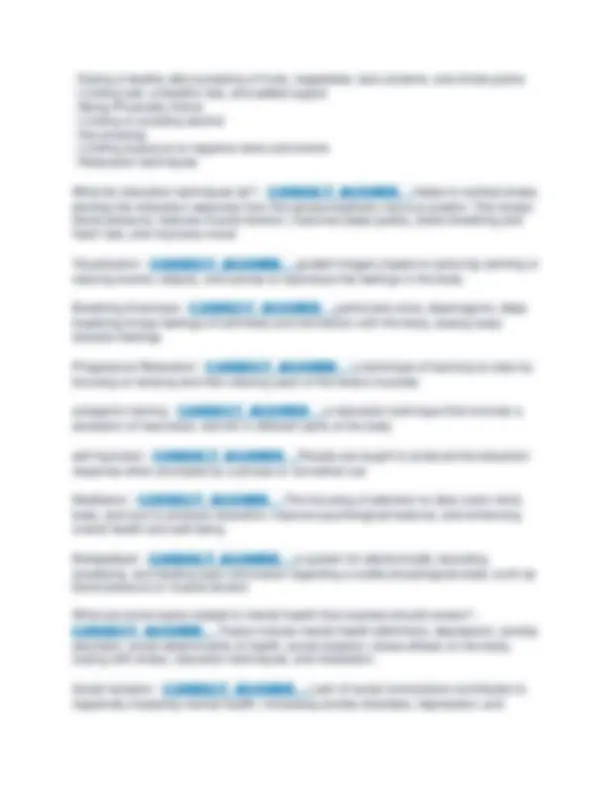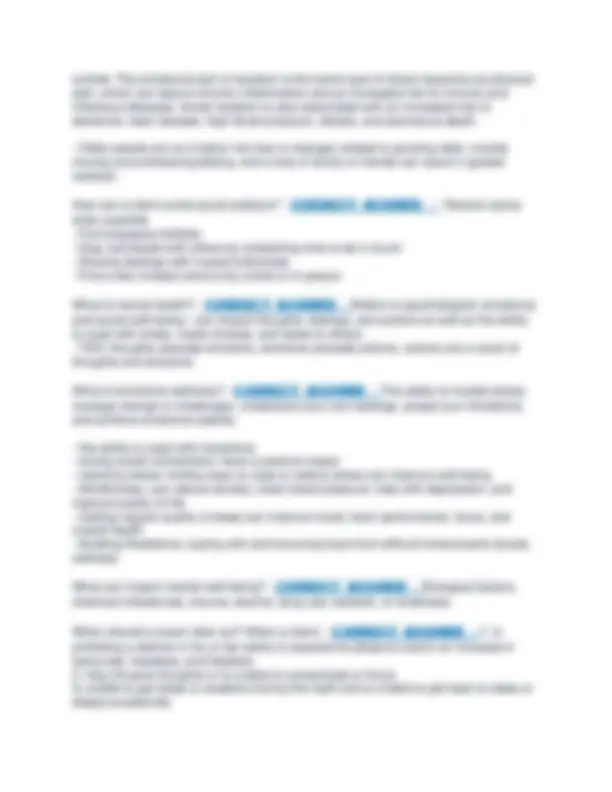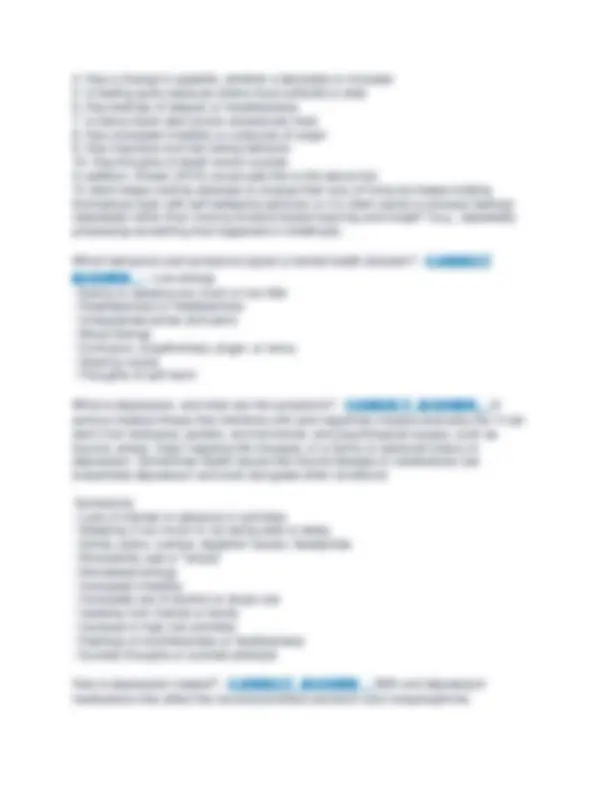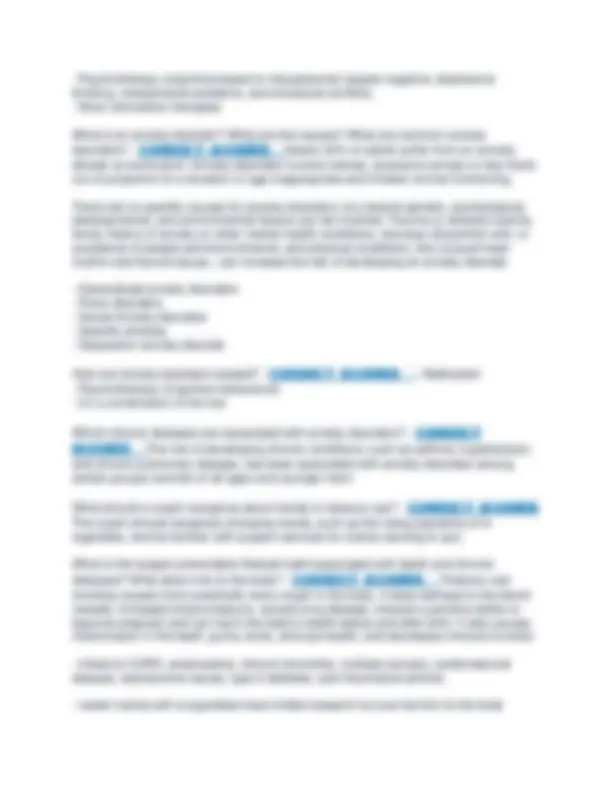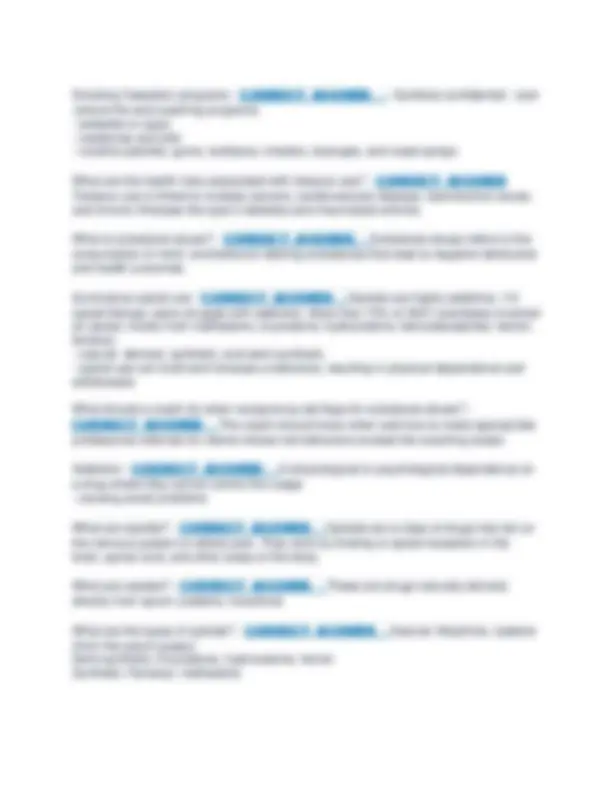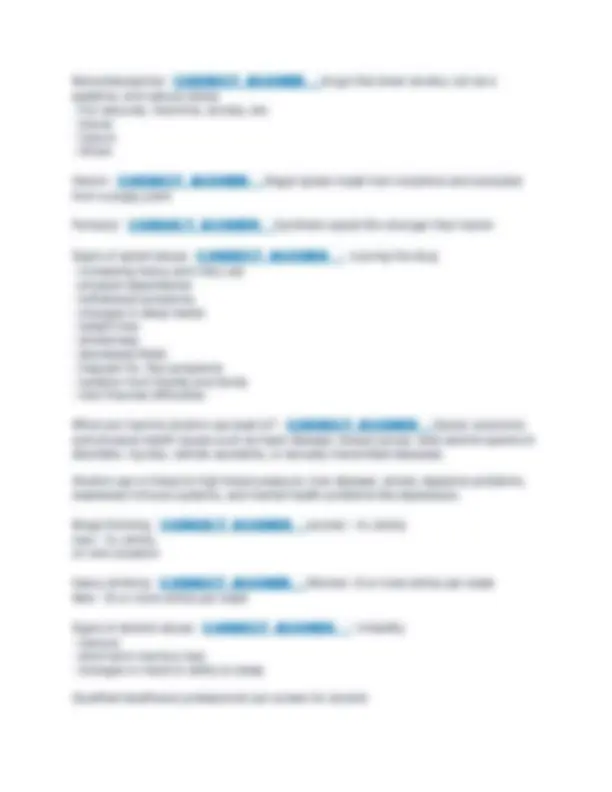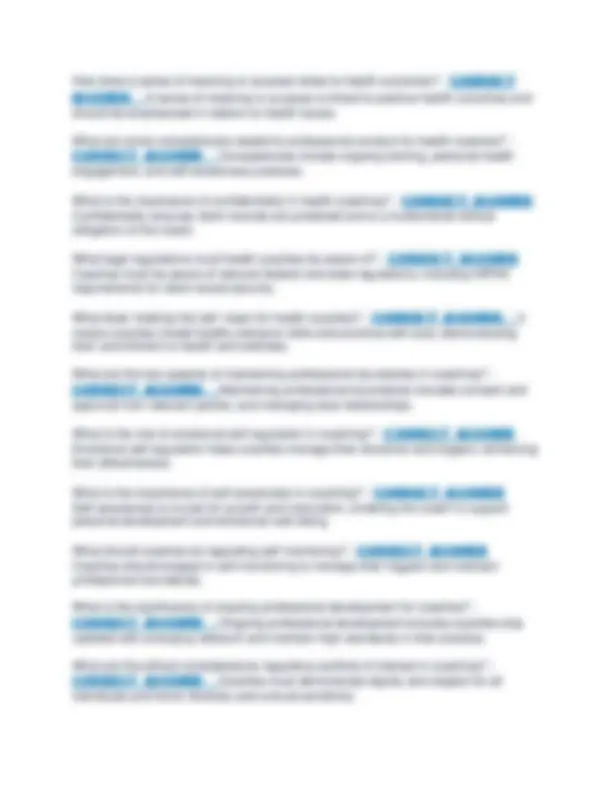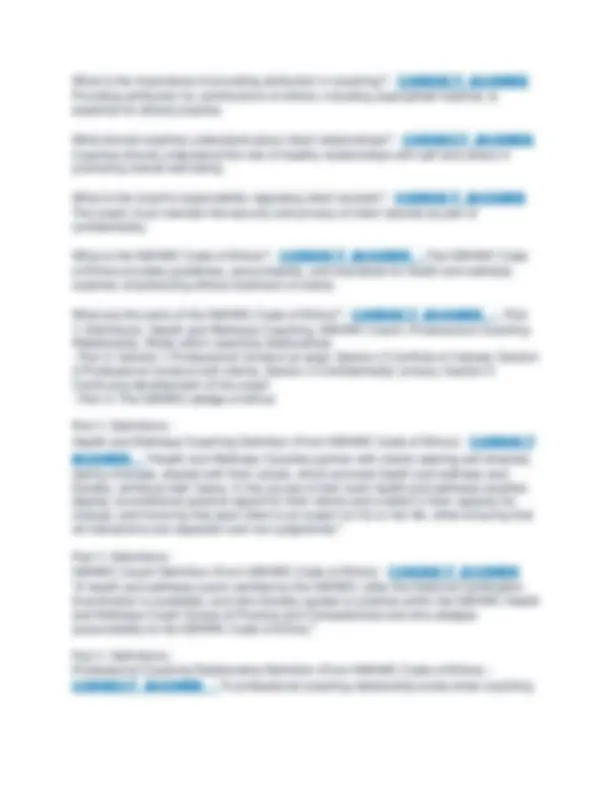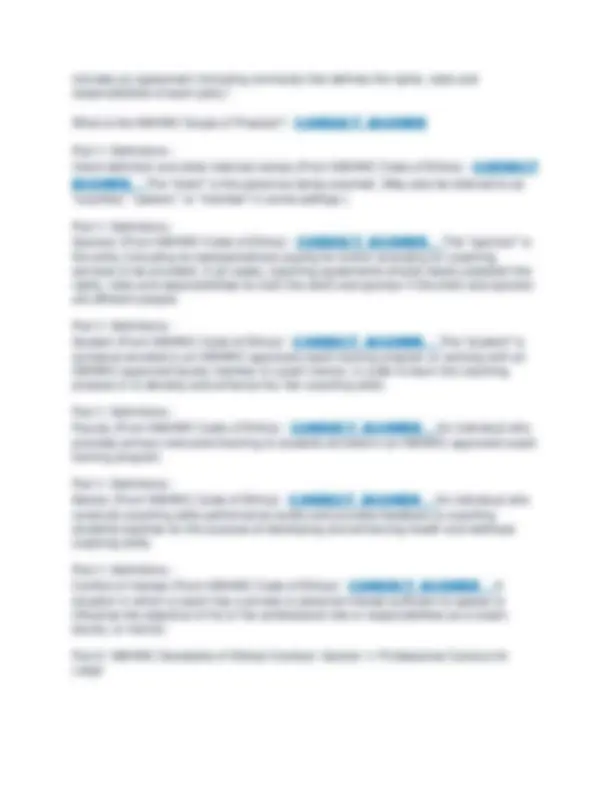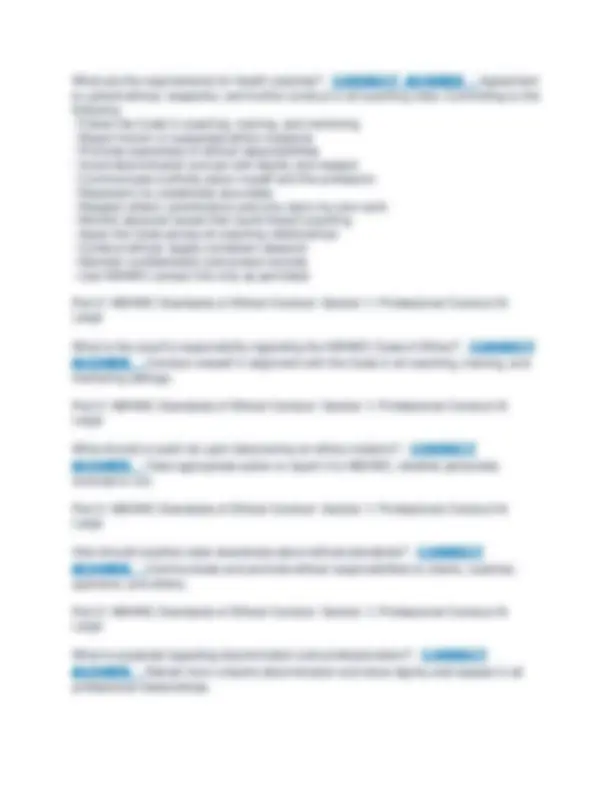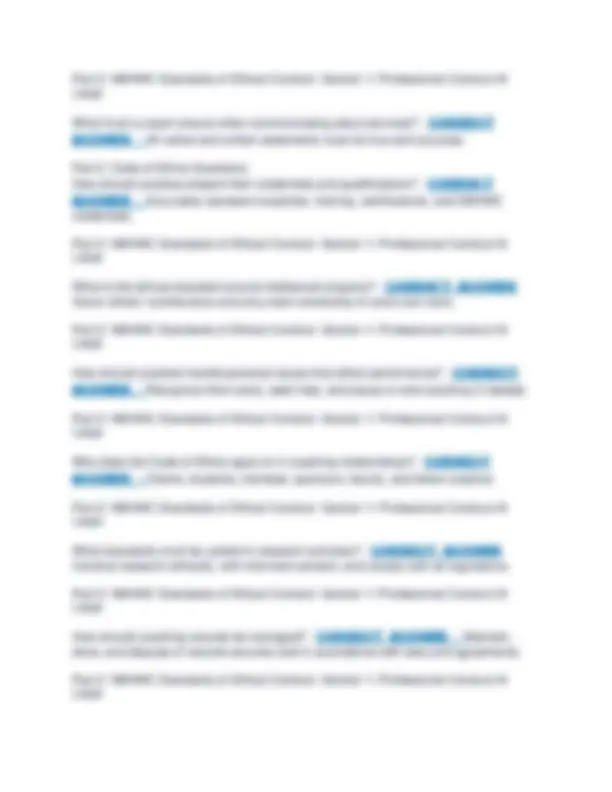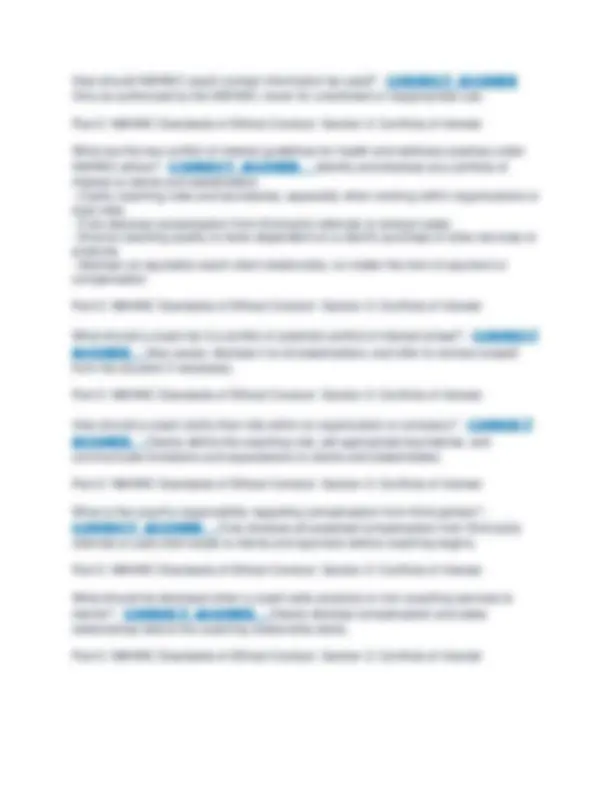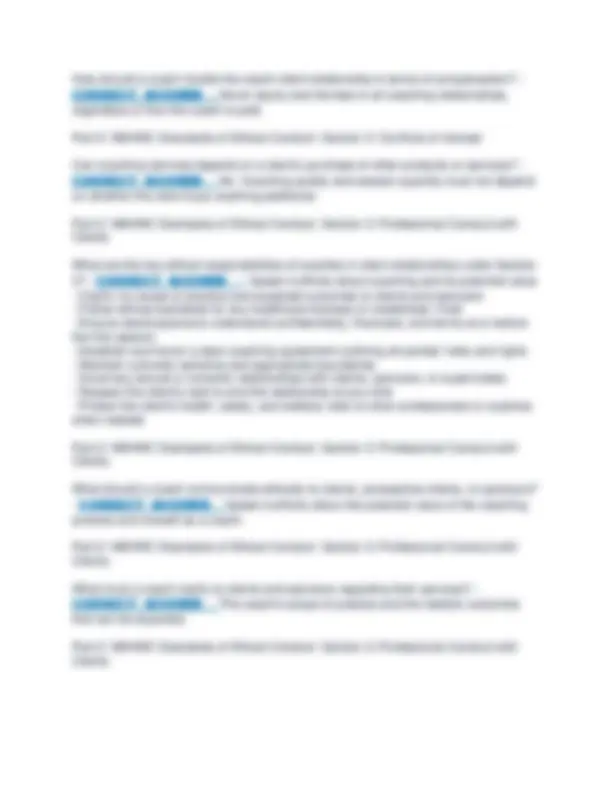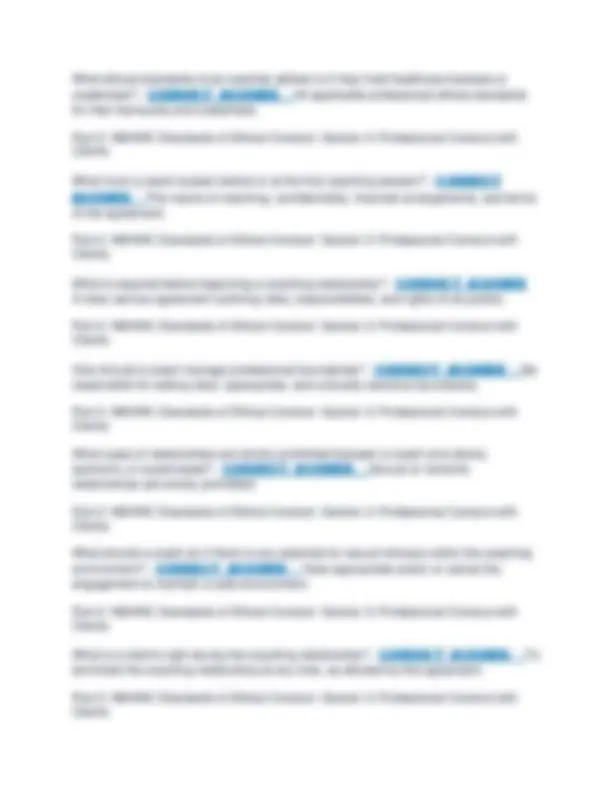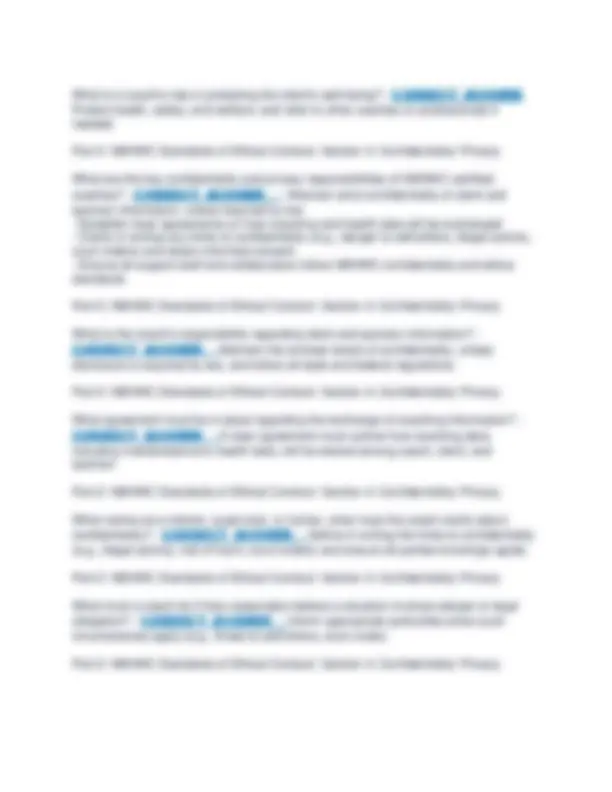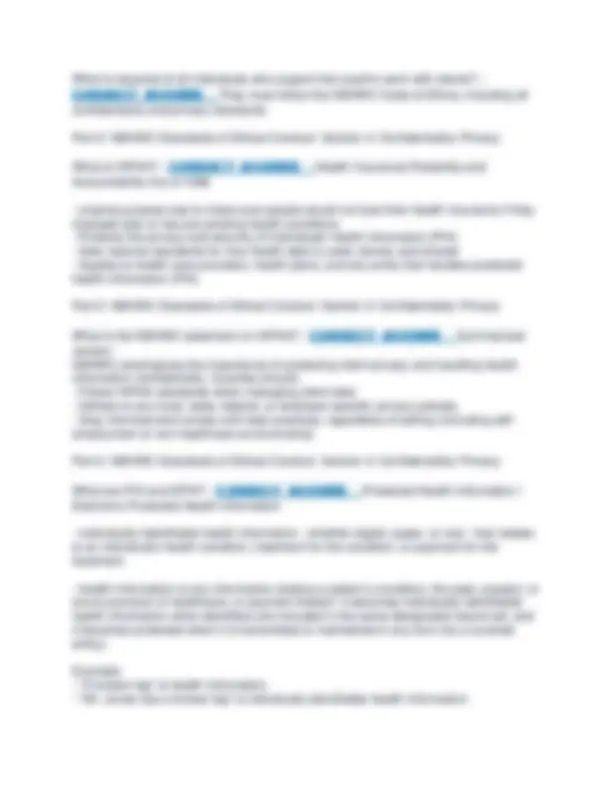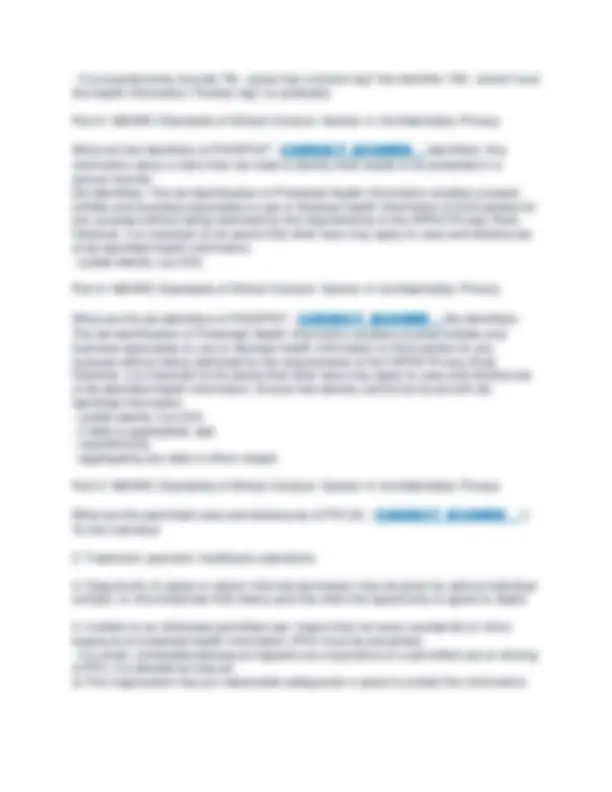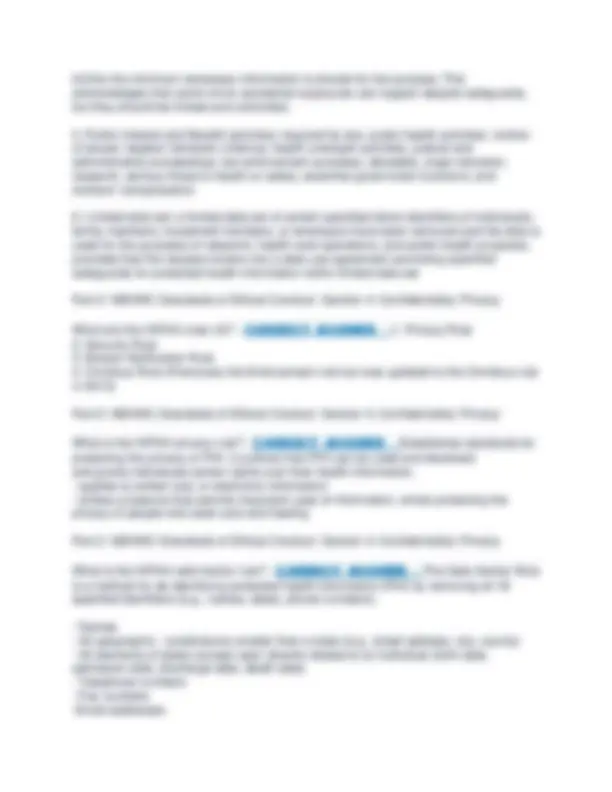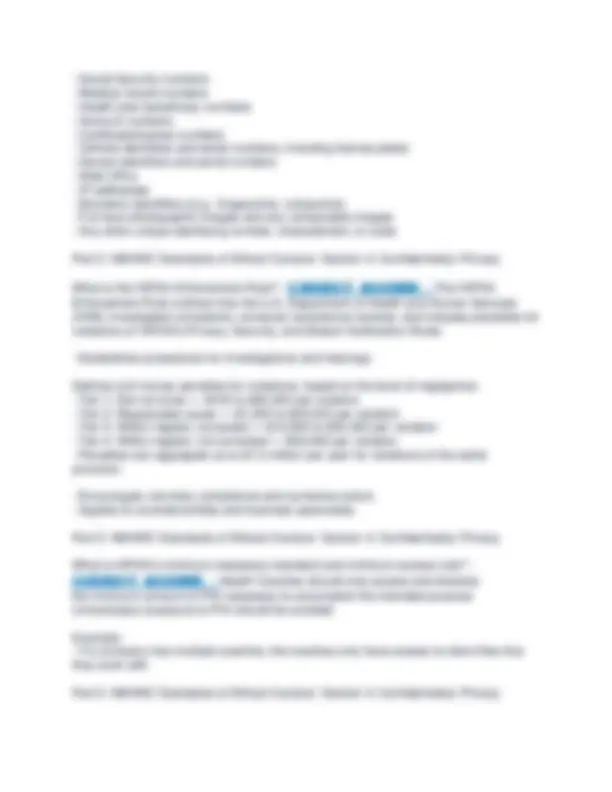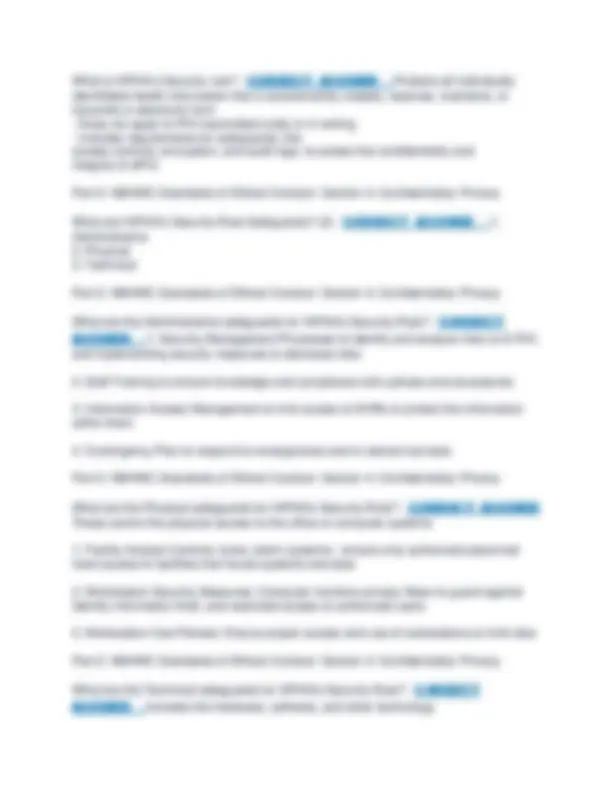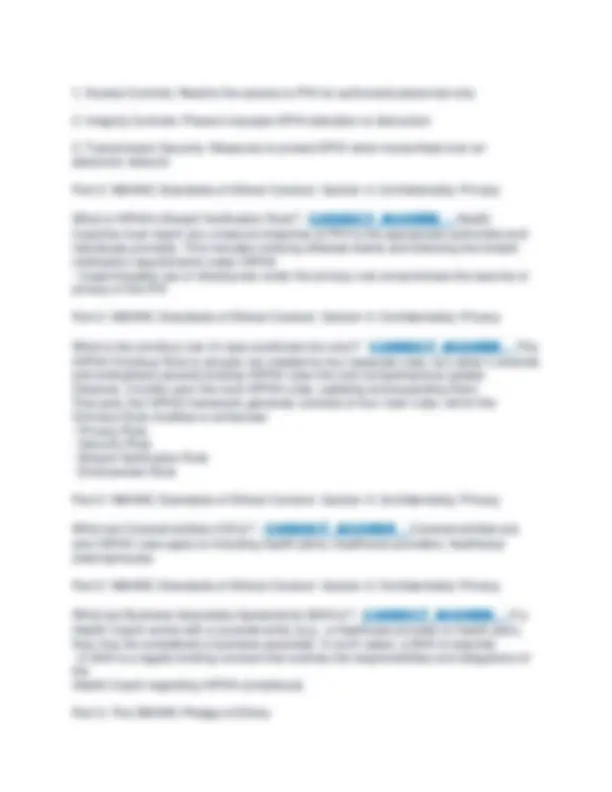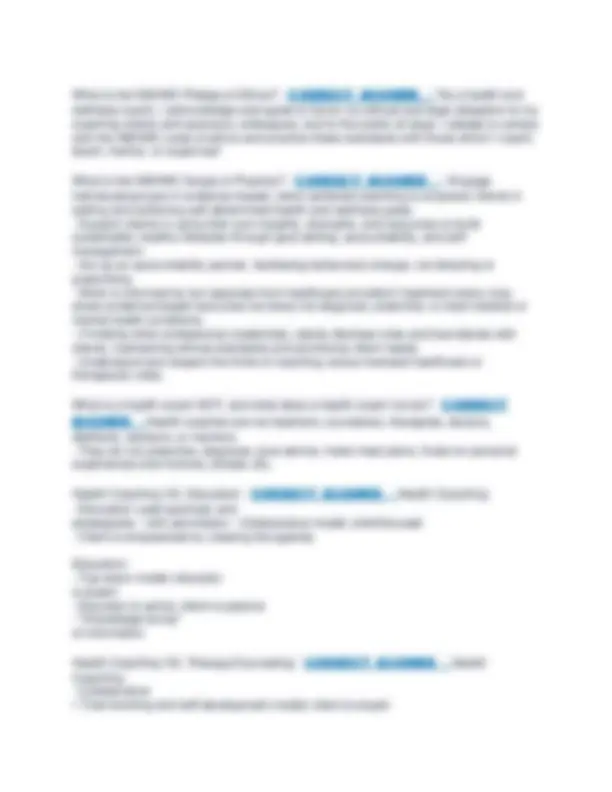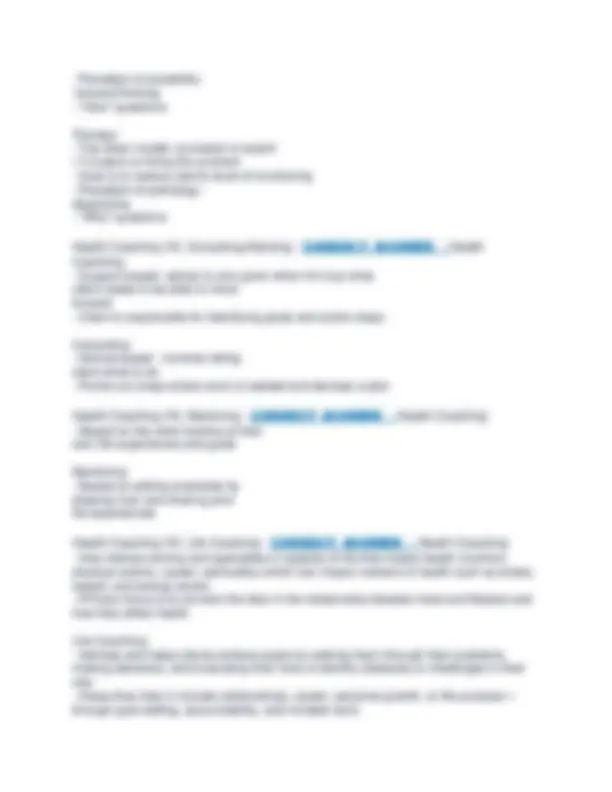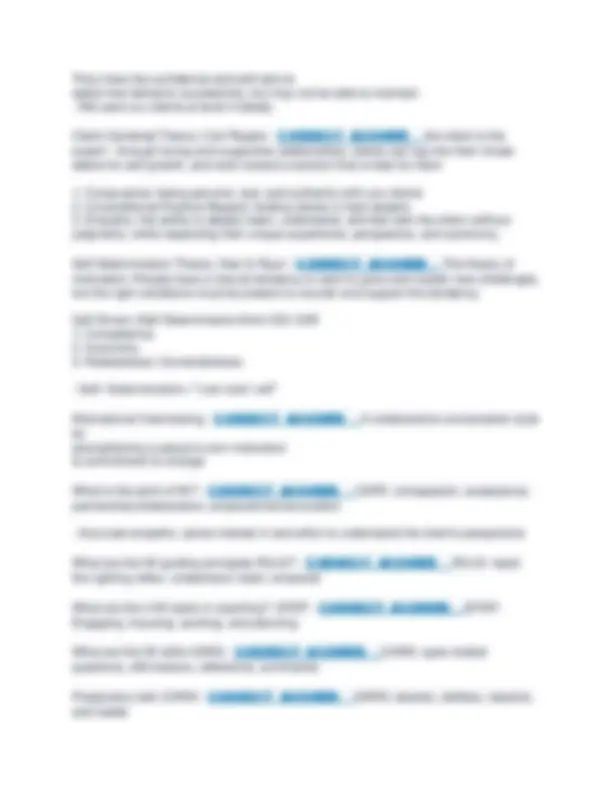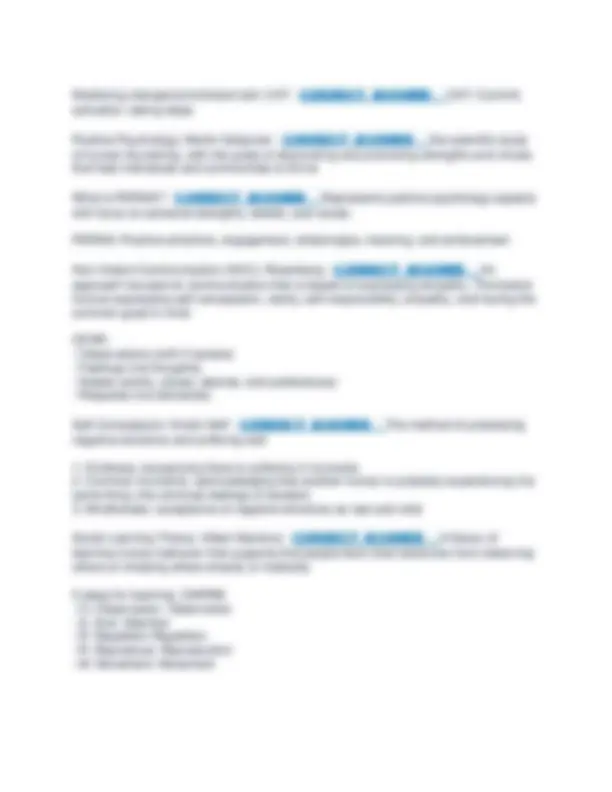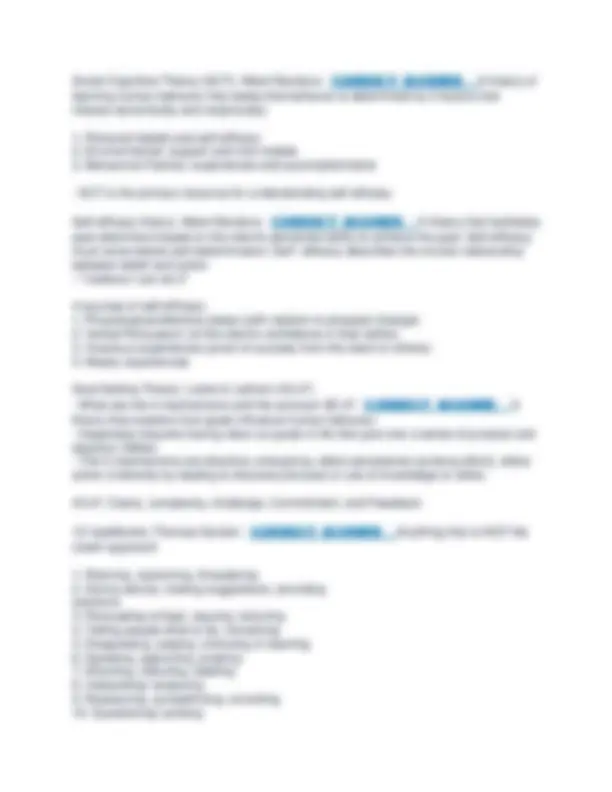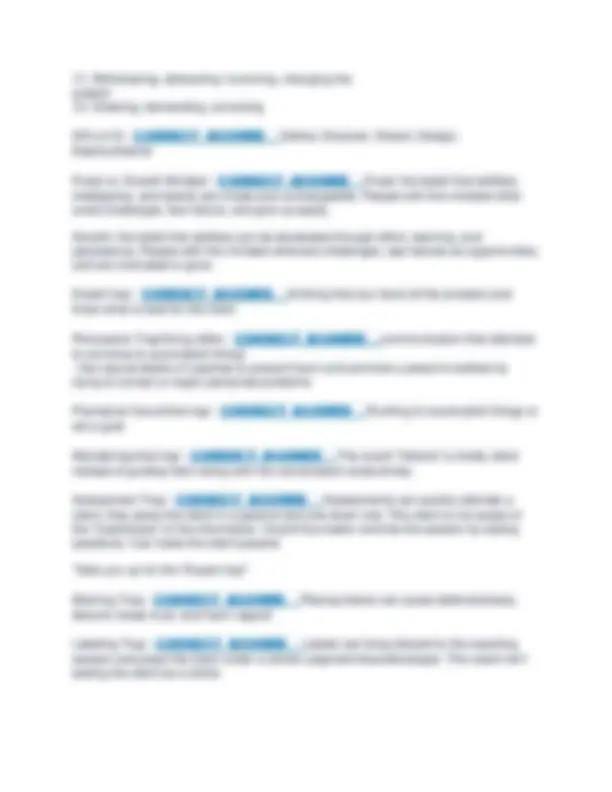Download NBHWC July 2025 Exam LATEST VERSION [ 421 QUESTIONS AND ANSWERS] WITH STUDY GUIDE DETAIL and more Exams Nursing in PDF only on Docsity!
NBHWC July 2025 Exam LATEST VERSION [ 421
QUESTIONS AND ANSWERS] WITH STUDY GUIDE
DETAILED AND VERIFIED FOR GUARANTEED PASS-
LATEST UPDATE 2025 GRADED A TESTBANK
What should a coach do prior to a coaching session? - CORRECT ANSWER Review materials, eliminate distractions, and become mindful and present. How does a coach's state affect the client during a session? - CORRECT ANSWER A calm and present coach helps the client become calm and receptive, fostering self- awareness and self-discovery. What are the aims of the initial coaching session? - CORRECT ANSWER To describe the coaching process, review client information, and determine if the client is an appropriate candidate for coaching.
- Coach clarifies the roles and expectations of both the client and the coach What is established in the Coaching Agreement? - CORRECT ANSWER Guidelines and specific parameters of the coaching relationship:
- Interactions: Roles, responsibilities, the expectations of the coach and client, attendance and cancellation policies, establish boundaries, what is and is not appropriate, what is and is not being offered
- Logistics: when and where you will meet, how many sessions, duration of sessions, length of program, cost of program
- Cost of Program: fees and payments
- Confidentiality and Record Keeping What should a coach establish during the first session? - CORRECT ANSWER Rapport with the client and gauge their intentions for coaching. What is the coach's responsibility regarding client assessments? - CORRECT ANSWER To review assessments and other data sources, if any are used. What is the focus during early coaching sessions? - CORRECT ANSWER Exploring the client's values, vision, purpose, and priorities.
- Building trust and rapport
- wellness visions What is the coach's role in determining the focus of coaching? - CORRECT ANSWER The coach empowers the client to select an area that feels important, motivating, timely, and client-directed
What should a coach ensure regarding time management in sessions? - CORRECT ANSWER Ensure appropriate time management for this and all sessions.
- Respect the client and gently guide along back to the conversation if they get off track What is the significance of the coaching process overview? - CORRECT ANSWER It clarifies the expectations and responsibilities of both the coach and the client. What is the importance of establishing rapport in the first session? - CORRECT ANSWER It helps create a trusting relationship and sets a positive tone for coaching. What should a coach clarify about their role during the initial session? - CORRECT ANSWER That they will not diagnose or prescribe, nor give unsolicited advice. Examples of what the coach does and does not do, confidentiality, etc. What is the client's responsibility in the coaching relationship? - CORRECT ANSWER To self-determine their vision, goals, and action steps. What should be reviewed before determining if a client is suitable for coaching? - CORRECT ANSWER Information and assessments provided by the client.
- Assess client's intentions for coaching and their readiness What is the purpose of gauging the client's intentions for coaching? - CORRECT ANSWER To understand why coaching is sought and to align the coaching process with the client's needs. What is the expected outcome of the initial coaching session? - CORRECT ANSWER To confirm the coaching agreement and establish a clear understanding of roles and expectations. How should the coach handle logistics for the coaching session? - CORRECT ANSWER Confirm meeting location, conference call arrangements, and other logistical details. What is the role of the coach in the client's self-discovery process? - CORRECT ANSWER To facilitate exploration and reflection, allowing the client to uncover their own insights. What is the first competency in assessing a client's health and wellbeing? - CORRECT ANSWER Have the client assess their current state of health and/or wellbeing.
What is a key aspect of the coaching relationship? - CORRECT ANSWER It is client-centered, empowering the client to self-discover values and strategies. What drives the coaching relationship according to the competencies? - CORRECT ANSWER The client's agenda, needs, interests, and preferences. What should a coach do with their personal information during sessions? - CORRECT ANSWER Share it only when appropriate. How should a coach handle client beliefs and values? - CORRECT ANSWER Observe, name, and refer to the client's beliefs and values. What is the importance of trust and rapport in coaching? - CORRECT ANSWER It creates a positive environment where the client feels accepted and supported. What is the coach's primary role in the coaching relationship? - CORRECT ANSWER To serve as a facilitative partner, not as a content expert or educator.
- The client is driving the car, the coach is in the passenger seat helping them navigate How should a coach adjust their approach during sessions? - CORRECT ANSWER According to the client's health literacy, learning style, and preferences. What should a coach communicate about the client's capabilities? - CORRECT ANSWER Convey the belief that the client is resourceful and an expert in their own experience. What is a key component of developing a sustainable pathway for clients? - CORRECT ANSWER Assisting in developing a maintenance/relapse prevention plan including available support and resources. How does a coach's confidence in a client affect the client? - CORRECT ANSWER It supports the client's self-efficacy. What is one way a coach builds trust with a client? - CORRECT ANSWER By attending to the client's emotions as well as their words and behaviors.
- Active listening, mirroring, empathy, compassion, mindfulness, reflections, and summaries to show the coach is present and paying attention What should a coach do when they sense conflict or discomfort in a client? - CORRECT ANSWER Acknowledge what is happening with curious interest. What are the key competencies related to trust and support in coaching? - CORRECT ANSWER 1. Demonstrate benevolence, honesty, sincerity, and authenticity. 2.
Convey unconditional positive regard. 3. Follow through on commitments. 4. Address discord/conflict openly and resolve it timely. What does active listening involve beyond verbal communication? - CORRECT ANSWER It includes being attuned to nonverbal cues such as expression, tone, emotions, and energy. What is the purpose of using silence in coaching? - CORRECT ANSWER To hold the space for clients, allowing them time to reflect, process, and identify what emerges.
- WAIT (Why Am I Talking?) What are some competencies related to active listening? - CORRECT ANSWER
- Be attentive and mindful. 2. Be open-minded. 3. Be curious without assumptions. 4. Pace communication to fit client's needs. 5. Listen for what is not being said. 6. Use silence appropriately. How can emotions impact a client's learning and change process? - CORRECT ANSWER Emotions can generate insight and affect the brain's capacity for learning and change. What role does self-compassion play in coaching? - CORRECT ANSWER It allows for a more honest appraisal of behaviors and promotes better self-care. What should a coach do to support a client's emotional state? - CORRECT ANSWER Attend to the client's state of being, acknowledge their emotions, and foster self- compassion. What is the purpose of reflections in coaching? - CORRECT ANSWER Reflections convey active listening and provide clients the opportunity to witness their own words and beliefs. What types of reflections can a coach use? - CORRECT ANSWER 1. Simple reflections:
- Double-sided reflections
- Amplified reflections
- Summaries How can a coach help expand a client's thinking? - CORRECT ANSWER By asking curious, open-ended questions that encourage exploration and self-reflection. What types of questions should a coach use to evoke deeper thinking? - CORRECT ANSWER Open-ended questions that start with 'what' or 'how'.
What is the role of the coach's intuition in the coaching process? - CORRECT ANSWER To guide the conversation and decisions based on the coach's insights and feelings. What techniques help narrow the conversation toward decisions and goal-setting? - CORRECT ANSWER Techniques such as closed-ended questions, interrupting and redirecting, bottom-lining, and scaling questions. What are scaling questions in coaching? - CORRECT ANSWER Questions that use a scale of 0-10 to assess readiness, importance, confidence, commitment, or motivation. What is the objective of assisting clients to evaluate and integrate health information? - CORRECT ANSWER To ensure clients are well-informed about their health and can utilize various health resources effectively. What types of sources may a coach help a client evaluate for health information? - CORRECT ANSWER Health care provider input, health assessments, health risk assessments, basic biometrics, and referrals. What is the importance of setting goals and action steps in coaching? - CORRECT ANSWER Small, gradual successes predict long-term engagement and help clients move toward self-determined goals. What model does a coach apply to recognize a client's stage of change? - CORRECT ANSWER The Transtheoretical Model. What does SMART stand for in goal-setting? - CORRECT ANSWER Specific, Measurable, Achievable/Attainable, Realistic/Relevant, Timely. What is the difference between behavioral goals and outcome goals? - CORRECT ANSWER Behavioral goals focus on the process and learning, while outcome goals focus on the final results. How should a coach approach client progress reviews? - CORRECT ANSWER By emphasizing the client's effort and learning rather than solely focusing on outcomes. What is the purpose of positive reframing in coaching? - CORRECT ANSWER To shift client perspectives to a more positive view, enhancing motivation and progress. What is the significance of behavior tracking in coaching? - CORRECT ANSWER To help clients monitor their actions and progress toward their goals.
What does an accountability plan involve in the coaching process? - CORRECT ANSWER Developing a structured approach for clients to take responsibility for their actions and commitments. Why is it important to anticipate and plan for challenges in coaching? - CORRECT ANSWER To help clients navigate obstacles effectively and maintain progress toward their goals. What is the role of visualizing in the coaching process? - CORRECT ANSWER To elicit intrinsic motivation and clarify goal direction for the client. How does a coach facilitate perspective shifts for clients? - CORRECT ANSWER By reflecting the client's views and asking open-ended questions to enhance self- awareness. What is the importance of client engagement models in coaching? - CORRECT ANSWER To support clients in becoming active participants in their own health and wellness journey. What is the goal of incorporating various dimensions of a client's life in coaching? - CORRECT ANSWER To create a holistic understanding of the client's experiences and challenges.
- Multidimensional Health What is the role of self-talk in coaching? - CORRECT ANSWER The coach listens for the client's self-talk and helps them consider more positive self-talk.
- How one speaks to and about oneself may be revealed in behaviors What are the competencies related to reframing in coaching? - CORRECT ANSWER Reframe, address self-defeating perceptions, explore patterns related to client behaviors and decision tendencies, and awareness of self-talk. What is the focus of coaching psychology regarding client motivation? - CORRECT ANSWER Coaching psychology focuses on eliciting the client's intrinsic motivation based on their purpose, meaning, values, and preferences. What are the competencies involved in eliciting a client's perspectives? - CORRECT ANSWER Elicit reasons for change, solutions, ideas, experiments, desires, reactions, desired outcomes, and rewards/incentives. What does self-determination theory emphasize in coaching? - CORRECT ANSWER It posits universal needs for psychological health: autonomy, competence, and relatedness.
What is the role of community resources in coaching? - CORRECT ANSWER Community resources help clients build a support system that enables ongoing success after coaching. What is the relationship between self-efficacy and behavior change? - CORRECT ANSWER Self-efficacy influences the client's belief in their ability to initiate change and achieve goals. What are the components of self-determination theory? - CORRECT ANSWER Autonomy, competence, and relatedness. How can a coach support a client in problem-solving? - CORRECT ANSWER By engaging the client in evaluating options and considering both short and long-term benefits. What is the outcome of a trusting environment in coaching? - CORRECT ANSWER It allows clients to safely experiment with new ideas and behaviors. What is the purpose of reflecting positive emotions in coaching? - CORRECT ANSWER To help clients develop positive psychological resources. What has positive psychology demonstrated the value of? - CORRECT ANSWER Positive resources in improving creativity, open-mindedness, strategic thinking, resilience, connection, and health. How can positive psychological resources be increased? - CORRECT ANSWER By identifying, exploring, cultivating, and affirming skills, efforts, strengths, values, positive emotions, optimism, and resilience. What is the primary role of health and wellness coaches regarding health or disease? - CORRECT ANSWER They are not content experts and do not diagnose or prescribe unless they have credentials allowing it. What should health and wellness coaches be familiar with? - CORRECT ANSWER Current evidence-based recommendations from public health groups like the CDC and NIH. What areas do relevant health guidelines and recommendations cover? - CORRECT ANSWER Health promotion, disease prevention, and lifestyle medicine.
What is an important focus for health and wellness coaches? - CORRECT ANSWER Recognizing potential imminent danger and medical red flags, and knowing when to refer clients to healthcare professionals. Why is it important for coaches to stay updated on health guidelines? - CORRECT ANSWER Recommendations change frequently and vary by organization, impacting client choices and resources. What is the coaching relationship primarily centered on? - CORRECT ANSWER Determining what the client already knows, needs, and wishes to learn. What general knowledge is required for health and wellness coaches? - CORRECT ANSWER Knowledge about healthy living to facilitate various competencies in coaching conversations. What is a valuable resource for coaches and clients provided by the CDC? - CORRECT ANSWER A robust, evidence-based website with useful health information. What is Healthy People 2020? - CORRECT ANSWER A program of nationwide health-promotion and disease-prevention goals set by the U.S. Department of Health and Human Services. What does wellness encompass beyond the absence of disease? - CORRECT ANSWER All aspects of physical, psychological, spiritual, and social well-being. What perspective do many coach training programs emphasize? - CORRECT ANSWER A whole-person perspective using frameworks like a wellness wheel. What are the key topics for review regarding wellness and well-being concepts? - CORRECT ANSWER Health-related quality of life, well-being concepts, and the Travis Illness-Wellness Continuum. What is the Travis Illness-wellness continuum? - CORRECT ANSWER Wellness is not merely the absence of disease, but extends beyond into awareness, education, and growth. The continuum goes from premature death to high-level wellness. Individuals can travel along the continuum throughout life. Neutral point would be the absence of disease without further growth What is HRQOL and well-being - CORRECT ANSWER Health-related quality of life: A multidimensional measure of how physical, mental, emotional, and social well- being affect a person's overall quality of life.
- CDC: Focuses on self-rated health and "healthy days."
What are some common chronic diseases and conditions that coaches should understand? - CORRECT ANSWER Hypertension, diabetes, obesity, cardiovascular disease, high cholesterol, and metabolic syndrome. What role does inflammation play in chronic diseases? - CORRECT ANSWER Chronic inflammation is a common factor in most chronic diseases, causing problems over time. What are some conditions associated with chronic inflammation? - CORRECT ANSWER Coronary artery disease, diabetes, obesity, arthritis, cancer, and Alzheimer Disease. What is blood pressure? How is blood pressure read, and what do the numbers mean? What are the following blood pressure levels: Normal, elevated, and hypertension - CORRECT ANSWER Blood pressure is the force of blood pushing against the arterial walls. Blood pressure is read as a fraction with systolic over diastolic.
- Systolic is the pressure of the blood in the arteries when the heart pumps/squeezes/beats.
- Diastolic is the pressure of the blood in the arteries when the heart relaxes/rests. Normal: less than 120/80 mm Hg Elevated: 120-129/less than 80 mm Hg Hypertension: higher than 130/higher than 80 mm Hg What are the basic topics for review regarding hypertension? - CORRECT ANSWER Blood pressure basics, signs and symptoms, effects of high blood pressure, measuring, and controlling blood pressure. What are the signs and symptoms of high blood pressure? - CORRECT ANSWER Known as the "silent killer"
- Headaches, shortness of breath, nosebleeds, and flushing. What is the significance of measuring blood pressure? - CORRECT ANSWER It helps in diagnosing hypertension and monitoring treatment effectiveness. What are some risk factors for hypertension? - CORRECT ANSWER - Medical conditions such as obesity or diabetes
- Behavioral/lifestyle choices such as physical inactivity, alcohol and tobacco use, or unhealthy eating habits
- Family history or genetics: genes and common shared environments as well as age, sex (women can develop it during pregnancy), and ethnicity
How can blood pressure be controlled? - CORRECT ANSWER High blood pressure can be managed or prevented with healthy lifestyle changes:
- Increased physical activity: @ least 150 min of moderate physical activity/week for adults w/ 2 days of muscle strengthening activities
- Improve diet and limit sodium and alcohol intake
- Managing stress
- Not Smoking
- In some cases, using blood pressure medication as prescribed by a medical doctor Why should someone lower their sodium intake if they have high blood pressure? - CORRECT ANSWER Sodium helps to balance fluids in the body and plays a role in how the muscles/nerves work; the kidneys balance the amount of sodium in the body
- Sodium attracts and holds on to H20. Too much sodium results in an increase in the blood volume, directly causing the heart to work harder to pump, and increasing the blood pressure in the arteries What should be reviewed regarding diabetes? - CORRECT ANSWER About diabetes, who's at risk, symptoms, prediabetes, type 2 diabetes, and getting tested. What is diabetes? How does it affect the body? - CORRECT ANSWER Diabetes is a chronic disease that occurs when the pancreas does not produce enough insulin (a hormone that regulates blood glucose) or the body cannot effectively use the insulin it produces, impacting how the body turns food into energy
- The body typically breaks down the food you eat into glucose/sugar and releases it into the bloodstream. As blood sugar increases, the pancreas releases insulin.
- Diabetes prevents the body from making enough insulin or using it as well as it should, resulting in too much blood sugar staying in the bloodstream, leading to health problems over time, such as vision loss, heart or kidney disease How can diabetes be prevented or managed? - CORRECT ANSWER - Type 1: No prevention or cure. Requires daily administration of insulin. Diet and lifestyle adjustments can help prevent complications
- Type 2: Can be prevented with lifestyle and dietary adjustments
- Gestational: lifestyle and dietary adjustments
- Pre-diabetes: Lifestyle and dietary adjustments
- Lifestyle and dietary adjustments include: losing weight or maintaining a healthy weight, eating a healthy diet, getting regular physical activity, stress management, no tobacco use/smoking, and limit alcohol consumption What are typical diabetes symptoms? - CORRECT ANSWER - Urinating frequently, often at night
- Being very hungry or thirsty
- Having blurry vision or numb or tingling hands or feet
- Losing weight without trying
- Oral Glucose Tolerance Test (OGTT): for gestational diabetes testing is between 24- 28 weeks of pregnancy. The person must drink a liquid containing glucose What is Hemoglobin A1C? - CORRECT ANSWER a protein in the red blood cells that carries oxygen from the lungs to the rest of the body and returns carbon dioxide to the lungs to be exhaled. What is the A1C test? What are the measurements for normal, prediabetes, and diabetes? - CORRECT ANSWER A blood test that measures the average blood sugar level over the past 2 - 3 months. This is expressed as a percentage to reveal the percentage of hemoglobin in the blood that is coated with sugar. Glycated hemoglobin is HbA1C (hemoglobin with sugar attached).
- Normal: Below 5.7%
- Pre-Diabetes: 5.7%-6.4%
- Diabetes: 6.5% or above What is the fasting glucose sugar test? What are the measurements for normal, prediabetes, and diabetes? - CORRECT ANSWER A blood test that measures the blood sugar after an extended period of fasting (typically overnight about 8-12 hours). This test checks the blood sugar levels while not eating for a while, the insulin function, and how well the body is using insulin to regulate blood sugar levels, and the risk of diabetes.
- Normal: 99 mg/dl
- Pre-Dibates: 100-125 mg/dl
- Diabetes: 126 mg/dl or above What is the oral glucose tolerance test (OGTT)? What are the measurements for normal, prediabetes, and diabetes? - CORRECT ANSWER Blood tests can be taken to measure blood sugar at the time of testing and after drinking a liquid with glucose every 30-60 minutes for a few hours
- Normal: 139 mg/dl
- Pre-Diabetes: 140-199 mg/dl
- Diabetes: 200 mg/dl or above What are the typical blood sugar targets before a meal and 2 hours after eating? - CORRECT ANSWER - Before: 80-130 mg/dl
- 2 Hours After: greater than 180 mg/dl What are the key topics for understanding obesity? - CORRECT ANSWER Obesity causes and consequences, assessing Body Mass Index (BMI) and waist circumference, and abdominal obesity.
What is the relationship between obesity and health? - CORRECT ANSWER Obesity is linked to various health issues, including diabetes and cardiovascular disease. What are the causes and consequences of obesity? - CORRECT ANSWER Obesity is caused by a combination of:
- Behavioral factors - poor diet, physical inactivity, lack of sleep
- Environmental factors - limited access to healthy food, safe spaces to exercise
- Genetic and biological factors - metabolism, family history, hormonal conditions
- Psychosocial factors - stress, trauma, emotional eating, socioeconomic status
- Medications - some antidepressants, antipsychotics, steroids, and insulin
- Consequences: Increased risk of heart disease, type 2 diabetes, some cancers, joint problems, sleep apnea, and reduced quality of life. What is BMI, and what are the ranges for underweight, normal, overweight, and obesity classes I-III? - CORRECT ANSWER Body Mass Index is used to estimate weight status about a potential disease risk. BMI is a measurement of body fat based on a person's height and weight. Not a perfect measure of health because it does not take into account fat vs. muscle mass, body composition, ethnicity body composition, age, and sex differences. However, it can help assess overall health and identify potential risks associated with weight
- Underweight: less than 18.
- Normal: 18.5-24.
- Overweight: 25.0-29.
- Obesity Class I: 3 0 - 34.
- Obestiy Class II: 35- 39.
- Extreme Obesity Class III: greater than or equal to 40 What is waist circumference? What are the ranges for men and women? - CORRECT ANSWER Waist circumference is used to measure body weight, specifically fat distribution in the abdominal area. Excessive abdominal fat can indicate a greater risk of obesity-related conditions such as type 2 diabetes, high blood pressure, and coronary artery disease
- Normal: (M) 37 in. and below; (F) 31.5 in. and below
- Intermediate Risk: (M) 37.1- 39.9 in.; (F) 31.6- 34.9 in.
- High Risk: (M) 40 in. and above; (F) 35 in. and above What is the waist-to-hip ratio? - CORRECT ANSWER The measurement of the waist/hip in inches. expressed as a ratio. The risk of stroke increases once the measurement is above the following:
- Non-pregnant women: 0.85/ 85%
- Age: risk increases with age
- Family History: genetics as well as shared environments can increase risk
- Lifestyle: diets high in saturated fats, trans fats, and cholesterol; alcohol consumption; tobacco use; lack of physical activity What tests diagnose CAD and what do each one do? - CORRECT ANSWER - Electrocardiogram (ECG or EKG): measures electrical activity, rate, and regularity of heartbeat (electro-)
- Echocardiogram: uses ultrasound to create a picture of the heart (echo-)
- Exercise Stress Test: measures heart rate while walking on a treadmill to determine how well the heart works when it is pumping more blood
- Chest X-Ray: creates a picture of the heart, lungs, and other chest organs
- Cardiac Catheterization: uses a thin flexible tube inserted through an artery in the groin, arm, or neck to reach the heart and check the arteries for blockages (remember catheterization-- ter-- inter-- inter is like insert)
- Coronary angiogram: monitors blockages and blood flow through the coronary arteries by using X-rays to detect dye injected via cardiac catheterization (remember angiogram-
- gio-- gel-- gel is like dye)
- Coronary artery calcium scan: uses a CT (computed tomography) scan to look in the coronary arteries for plaque and calcium build-up Preventive and management measures for CAD - CORRECT ANSWER - Cardiac Rehabilitation
- Increase physical activity
- Improve mental health
- Manage stress
- Eat a healthy, low-fat, low-sodium diet; consume healthy beverages
- Quit/Avoid smoking
- Maintaining a healthy weight
- Check cholesterol levels (want total cholesterol at about 150)
- Control blood pressure (normal is less than 120/80)
- Manage diabetes and blood sugar
- Some may need medications What does cholesterol do in the blood? - CORRECT ANSWER Cholesterol is a lipid found in all cells of the body and is used to build cell membranes, create hormones, make vitamin D, and form bile acids that aid digestion of fats
- The body makes all the cholesterol it needs, so we do not need to get it through food
- LDL "bad" cholesterol---- Carries cholesterol to arteries, can build up as plaque. Increases the risk of heart disease and stroke
- HDL"Good" cholesterol----Carries cholesterol away from arteries back to the liver for removal. Protects against heart disease What does calcium do in the blood? - CORRECT ANSWER Calcium in the blood is essential for:
- Muscle contraction (including the heart)
- Blood clotting (helps form clots to stop bleeding)
- Nerve signal transmission
- Maintaining healthy bone structure (balances calcium levels with bones)
- Regulating enzyme activity and hormone secretion
- Too much calcium/Hypercalcemia: Fatigue, muscle weakness, kidney stones, confusion, irregular heartbeat
- Too little calcium/Hypocalcemia: Muscle cramps/spasms, tingling, numbness, seizures, cardiac arrhythmias What do triglycerides do in the blood? - CORRECT ANSWER Triglycerides are a type of fat that:
- Store energy for later use
- Provide insulation and protect organs
- Help transport and absorb fat-soluble vitamins (A, D, E, K)
- Excess triglycerides can contribute to plaque buildup in arteries, increasing heart disease risk What does the lipid panel makeup measure? - CORRECT ANSWER - Triglycerides - The primary form of stored fat; used for energy
- Total Cholesterol - Waxy fat used for cell membranes and hormone production
- Low-Density Lipoprotein (LDL) - "Bad" cholesterol that can build up in arteries
- High-Density Lipoprotein (HDL) - "Good" cholesterol that removes excess cholesterol from arteries Optimal Lipid Panel Levels - CORRECT ANSWER - Total cholesterol: about 150 mg/dl
- LDL: about 100 mg/dl
- HDL: (m) about 40 mg/dl; (f) about 50 mg/dl
- Triglycerides: less than 150 mg/dl What is the significance of understanding lipid panels? - CORRECT ANSWER They help assess cholesterol levels and cardiovascular risk. What are LDL and HDL cholesterol? What are optimal levels for men and women? - CORRECT ANSWER LDL is low-density lipoprotein (bad cholesterol), and HDL is high-density lipoprotein (good cholesterol). LDL: about 100 mg/dL HDL: (m) at least 40 mg/dL; (f) at least 50 mg/dL Risk factors for high cholesterol - CORRECT ANSWER - obesity
- type 2 diabetes
- not enough physical activity

